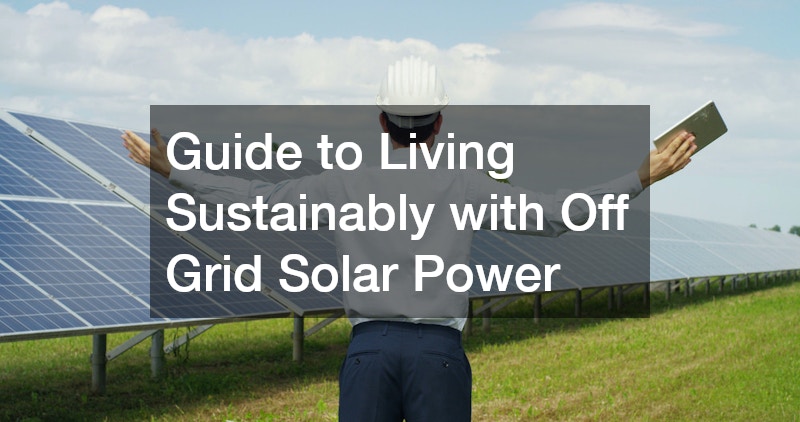Living sustainably has become an increasingly popular choice for Australians seeking to reduce their environmental footprint and gain more control over their energy consumption. One of the most effective ways to achieve this is through off grid solar power systems, which allow households to generate, store and use their own renewable energy independently of the main electricity grid. This approach not only helps lower carbon emissions but also provides long-term cost savings and energy security. However, living off grid comes with its own set of challenges, including system management, initial setup costs and ensuring a consistent energy supply.
How Does Off Grid Solar Power Work?
Understanding Solar Panels and Inverters
At the core of any off-grid system are solar panels, which capture sunlight and convert it into electricity. The energy generated is direct current (DC), which must be converted into alternating current (AC) using an inverter so it can power household appliances.
Modern inverters are highly efficient and often come with monitoring features, allowing users to track energy production and consumption in real-time.
Battery Storage Systems
A critical component of off grid solar is the battery storage system. Batteries store surplus energy generated during the day for use at night or during cloudy periods, ensuring a consistent supply of electricity. The size and type of battery required depend on your household energy needs, climate and the amount of sunlight your location receives.
Energy Management and Optimisation
Off grid living requires careful energy management to prevent power shortages. This may include scheduling high-energy tasks, using energy-efficient appliances and integrating smart home systems to monitor usage. Optimising energy consumption ensures your solar system runs efficiently, extends the life of your batteries and reduces the likelihood of needing supplementary power sources such as generators.
What are the Costs Involved?
Initial Setup Costs
The initial cost of an off-grid solar system can be high, covering panels, inverters, batteries, wiring, and installation, but it’s a long-term investment in energy independence and sustainability.
Long-term Savings
Despite the upfront costs, off grid solar can lead to considerable savings over time. By generating your own electricity, you reduce or eliminate electricity bills and in some cases, surplus energy can be sold back to the grid if your system is hybrid-enabled.
Potential Incentives and Rebates
Australian homeowners may be eligible for government incentives, rebates or renewable energy certificates that offset the cost of installing an off-grid system. These schemes vary by state and territory, so it is important to research local programs to maximise financial support.
What are the Benefits and Challenges of Going Off Grid?
Environmental Impact
Using off grid solar significantly reduces reliance on fossil fuels, lowering greenhouse gas emissions and helping combat climate change. By generating clean, renewable energy, households contribute to a more sustainable energy future while also encouraging broader adoption of solar technology in their communities.
Independence and Reliability
One of the main advantages of living off grid is independence from the traditional electricity network. This can be particularly valuable in rural or remote areas where grid access is limited or unreliable. Off-grid systems provide consistent power during outages, storms or other disruptions, enhancing household resilience.
Common Challenges and Solutions
Challenges include ensuring sufficient energy supply during periods of low sunlight, managing battery lifespan and addressing the complexity of system maintenance. Solutions may involve installing larger battery banks, using hybrid systems that integrate generators or seeking professional monitoring and maintenance services to optimise performance and longevity.
How to Choose the Right Off Grid Solar System for Your Needs?
Assessing Your Energy Requirements
The first step is to evaluate your household energy consumption. This involves identifying essential appliances, peak usage times and any future changes in electricity needs. Understanding your energy profile allows you to design a system that meets your requirements without overspending.
Understanding System Components
A well-balanced off-grid system includes solar panels, an inverter, a battery bank and monitoring equipment. Each component should be selected for efficiency, durability and compatibility. It is also worth considering expansion options for future energy needs, such as adding more panels or batteries as your household grows.
Selecting a Reputable Installer
Choosing an experienced and reputable installer is crucial for the success of your off-grid solar system. Professional installation ensures components are correctly configured, optimised for your location and compliant with Australian standards. A good installer will also provide ongoing support and maintenance advice, helping you get the most out of your investment.
Living sustainably with off grid solar power is a practical and rewarding way to reduce environmental impact, gain energy independence and save on electricity costs. While the initial investment and ongoing management require careful planning, the long-term benefits are substantial. By understanding how solar panels, inverters and battery storage work together, evaluating costs and savings and selecting a system tailored to your needs, you can make the transition to a more self-sufficient, environmentally conscious lifestyle.



